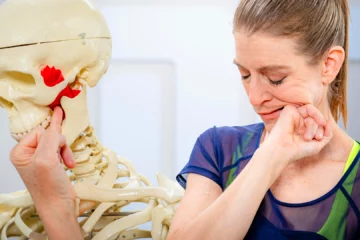
Considering we’ll likely take 20,000 breaths today, the understated muscle the diaphragm deserves attention.
“When the diaphragm stops flexing, air stops moving. After four minutes of that, pieces of the brain start to die. Folks who bravely survive muscular dystrophy — a genetic disease in which muscle fibers are unusually susceptible to damage and become progressively weaker — eventually pass away because of the failure of the diaphragm. When snake venom paralyzes all the muscles of the victim, suffocation is the cause of death because the diaphragm, too, is paralyzed.”
Louis Jackson, Yoga Tune Up® Instructor

The diaphragm is attached to lumbar vertebrae 3 and 4, the internal surface of the lower 6 ribs and shares its fascial sheath with the psoas and the quadratus lumborum. The posterior fascia of the diaphragm is contiguous with the lungs and its anterior surface with the ribcage lining and that of the peritoneum. These connections and the action of relaxation after contraction assist in the movement of blood to and from the heart. In fact, being a border crossing for the aorta, inferior vena cava and esophagus, the diaphragm is intricately involved in the delivery of blood to all organs and back to the lungs for reoxygenation. Knowing all this, wouldn’t you prefer to make it 20,000 nourishing daily breaths (instead of 20,000 lousy ones)?
The mechanics of breathing are summarized in the pictorial to the right: inhalation requires the contraction of the diaphragm, however the scalenes, sternocleidomastoid, pectoralis minor, serratus anterior and external intercostals also contract to elevate the ribs and sternum, which enhances diaphragm contraction and lung expansion. Exhalation requires contraction of transversus thoracis, internal intercostals, rectus abdominus, obliques and tranversus abdominus, effectively changing thoracic cavity volume and forcing air out.
The diaphragm is under both conscious and autonomic control – it is necessary for the diaphragm to contract in life and death scenarios (so blood is driven from digestive and reproductive organs to supply the muscles enabling the body to take flight or fight). Our modern lifestyles stimulate frequent (sometimes constant) facilitation of the diaphragm, which is one of the effects of stress on the body. Busy work schedules, less than healthy interpersonal relationships, PTSD, holding our core “in” on the inhale, mindless breath, skipping meals, sleep and schedule irregularities, ignoring emotional stresses and the list goes on… ARE all realised by the body as threats, facilitating the diaphragm and unconsciously stimulating the autonomic nervous system.
When the diaphragm is facilitated, it sets off the cortisol release response. Most of us can recall a surprising or stressful event, a phone call, door slamming loudly where we have literally subconsciously gasped. This stressed diaphragm contraction sets off a chain reaction that effectively shuts down digestion and causes a cascade of hormone reactions that, over time (if diaphragm is often contracted), can be associated with excess estrogen, testosterone and a depletion of progesterone. This hormonal imbalance can lead to menstrual, fertility, and implications on potential to sustain the womb for pregnancy (infertility/miscarriage).
When the diaphragm is facilitated, it also pulls on the fascia of the lungs, which can lead to shallow breathing, impeding the full function of the breath in delivering blood to the heart. Contraction of the diaphragm also pulls on the fascia of the peritoneum (gut area lining), which can impact digestion, bowel function and hormone balance. The myofascia’s of the diaphragm will also be taut from constant contraction. This can negatively influence the psoas and quadratus lumborum QL, who share its fascia and attachment points.
Apart from the stresses of modern life triggering its facilitation, the diaphragm cannot fully relax if there is constant tension in the iliopsoas, psoas, iliacus, quadratus lumborum, esophagus, and lungs which cross through it/share its fascia. In addition, peritoneal cavity organ disorders or adhesions (rampant due to high number of appendectomy, GB removals, hysterectomies, c-sections, bowel surgeries, estrogen dominance and endometrial growth etc) can pull on fascia causing diaphragm contraction and/or impeding relaxation.
In my 15 years of naturopathic practice, I have seen a big rise in cases of all the above, meaning most of my new clientele walk in mostly unaware of their overstimulated autonomic nervous systems and less than optimal diaphragmatic function.
The great news is that the diaphragm is under both conscious and autonomic control, which is where Yoga Tune Up® shines with tools to relax this incredible muscle. Relaxation of the diaphragm helps to increase the dominance of parasympathetic nervous system due to its close relation to the phrenic nerve (and minimising the risks outlined previously outlined).
Stay tuned for my favourite YTU tools (with videos of exercises) to down regulate your nervous system and relax your diaphragm in my next article!













THe more I learn about anatomy, the more aspects of my past physical lives begin to make sense. Once again, this article resonates strongly, knowing the facsia of my diaphragm are attached to L2-4 the area where I had my surgeries, strikes a painful and breathless cord. I look forward to continuing my journey in conscious competence of listening to my body and actually hearing my blindspots.
Thanks for reading. The follow up article with link to vids that may be of use is here. Warmly, Lee (your Australian Roll Model® Method Teacher Trainer!) https://www.tuneupfitness.com/blog/change-your-breath-change-your-health-lees-must-do-ytu-moves-for-the-diaphragm-and-core/
Great read Lee! It’s sad that so many people don’t understand how the diaphragm works. Lucky for them you can show them how to relax and breathe 🙂
Thanks for connecting all the factors that can inhibit the diaphragm from functioning optimally. Our 20,000 breaths we take daily can and should be nourishing. Poor breathing can truly cause a decline in health.
Wow! This is fantastic. I am so intrigued the more I am learning about my diaphragm. It is deeply intelligent. And I didn’t know that it can create discord in my nature hormone functionality. It comes with great responsibility that our modern lifestyles stimulate frequent (sometimes constant) facilitation of the diaphragm, which is one of the effects of stress on the body.. It makes so much sense that the body and diaphragm don’t ignore emotional stresses in the body and actually see these scary or fear based events as threats and can set off a chain of reactions that affects digestion and hormones. Thankfully the diaphragm is a great communicator and compensator and is willing to relax through the process of specific exercises. Thank you for your insight!
Love learning about the diaphragm and the great techniques to help my clients to unlock their breath!
Your post truly highlights how everything is connected. Our breathing, and the functions associated with it, truly affect everything. And since we can control it — its a great place to start to assess and make changes.
Interesting that breath function is connected to so many imbalances, dysfunction and disease. I will further look into breath and hormonal imbalances to get a greater understanding of this of infertility, pms, peri-menopause, and menopause. And the learning takes a deeper dive. Thank you. Namaste
Wow.. This is such an amazing topic!! I have to dig more into this and bring a lot more awareness to my breathing! It also confirms why my meditation practice is affecting my life so fast on so many levels!! Thx Diaphragm!!
Wow…Thank you for sharing your experience and knowledge. I was amazed at the correlation between diaphragmatic stress and hormonal effects. And I found it very interesting how so many disorders and issues can stem from a diaphragmatic related origin.
Wonderful summary of many of the breathing problems going on today. Looking forward to reading the next instalment for tips and tricks to improve our most basic and necessary action of life! Breathe, stay calm, and Yoga Tune Up* on!!
This has some great info on breathing. We were discussing in class the connection of the diaphragm to the papas and QL but it’s interesting to know that it can also impact digestion and hormone balance. Thanks for the info!
The information in this post provides great detail and general scope of what is happening in the breath of an individual that is often stressed out. It wasn’t until more recently that I started to realize how shallow my breathing really was – the only time I really get some good quality air movement running through is during my spin classes every week. Sitting at a desk in a fixed position during the day, and the ever present fight or flight feeling has started to impact how I feel physically every day – and based on this article, it is largely in my hands to figure out better breathing techniques to correct this. I’m interested to learn more about the function of the diaphragm – this provides great context as to what impacts it. Thanks for the introduction to yt another (controllable) part of my body!
Wow. I knew the diaphragm was a big deal but this post takes it to a whole new level! I never thought about the chemical and hormonal imbalances it could also contribute to in the body. Now I have even more ammunition for my case against bad breath! I will be book marking this one for sure.
What a great article on drawing attention to the importance of keeping the tissues in the diaphragm healthy. When we have one muscle working 20,000 times a day if its not working to the best of its ability or in the wrong direction it could be causing so much damage that we don’t even know about! I was very surprised to see that it can cause issues with estrogen, testosterone, and other hormonal issues. I would like to play with some ball work to see how it affects my breathing (in relation to the peace that discusses of the fascia of the lungs effect the shallowness of our breathing). Thank you for the great information!
I can testify to the power of diaphragmatic breathing from my experience as a wellness coach over the past 2 years. My clients are almost all hypertensive, and I have routinely seen systolic pressure drop as much as 20 mmHg after only 2 minutes of guided deep breathing. The “20-30,000 breaths” factoid (which I believe originates from the American Lung Association) is something i always share with clients and classes. It is the best example I know of the maxim “small changes- big results.”
I had no idea how large a role the diaphragm can play in hormone imbalances and digestive issues. It makes me feel even more confident in the power of belly breathing and other yogic breaths that help to activate the parasympathetic nervous system and help to reduce stress levels. I look forward to trying some of the YTU tools to down regulate the nervous system that go along with this.
This outlines simply how our respiratory system works and highlights the importance in maintaining a healthy balance. A great refresher.
this post is a fantastic summary of how everything is interrelated and its all one big domino effect. i think the effect on breathing from stress, injuries, immobility, etc, is one of the most under looked health and wellness issues. we must educate students about the role of breath and how the YTU work will help unlock so much potential in the breath and their body. in the anatomy training this weekend, we discussed how mindful breathing at the beginning of a class is important, but it doesnt always mean a student will be able to relax or feel more at ease-if physical issues in other areas that connect in with the diaphragm are affecting the breath-maybe they cant belly breathe easily-maybe no matter what they do the breath is in the upper part of the chest. part of our job as YTU teachers is to look for this, help generate the awareness and offer solutions.
Very good blog post, thanks for the reminder of the body’s total integration. the connection between diaphramic breathing and the body’s digestive functions and hormonal balance, as well, it’s connection to psoas QL. The power of the Breath.
Hi Lee-Ann!
I never considered the idea of how the aorta, inferior vena cava and esophagus pass through the diaphragm. In addition to a tight diaphragm being able to affect how blood flow, what about digestion also? Especially when you consider the sympathetic nervous systems responses. I think it’s amazing how the rise of so many health issues seem to be occurring and in the Western world, we turn to medications, when it could be as easy as beginning to change how we breathe.
Wow, thank you LeeAnne for the in-depth connections between the Diaphragm and other muscles/ fascial connections. This article beautifully articulates the quantifiable importance of the breath.
The intricacies of something that can also be autonomic are really fascinating. It’s especially interesting that a student might not be able to just “breathe more”; their diaphragm may not be able to fully relax quite yet.
It’s fascinating learning more about the relationship between the diaphragm and the peritoneal cavity, thank you, Lee-Anne!
Great post. I work with athletes and a big part of our practice is working on becoming aware of their breathing. I keep telling them- we “play football”, we don’t “think football”. The breath is such an amazing focal point and it keeps them playing from their shoulders down, not just focused in their mind.
Great point that the diaphragm can’t relax with particularly tight muscles. I love to work on my psoas with a YTU ball and i can take such big breaths after!
Thank you for all the details and technical aspects of the diaphragm, as well as the effects of stress in relationship to our lungs and diaphragm, helpful info to share with those just discovering a new way to be/breathe. I always emphasize better breathing in my classes, and tell people if they take nothing else from the class, to improve their relationship with their ‘life patner’ the breath, as they have a chance every waking moment to bring their awareness to their breathing.
This has been a huge topic of conversation in all my classes lately! It is truly amazing how little many know about their own breath function, but also amazing how big changes can happen with even the smallest first steps. Great article, thank you!